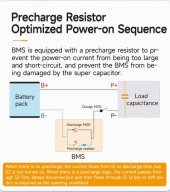Hi!
I am investigating into options for a offgrid hybrid application. It is an application where i need as much capacity as possible, but don't have the resources to purchase as big of a pack as i want this year. I want the option to expand the battery pack with lithium packs later on. The pack i am considering purchasing is 16 kWh (repurposed EV battery) and uses a Daly Smart BMS. I see that Daly now offers what they are calling Parallel modules as accessories to the Daly Smart BMS. I guess the idea is to have some sort of active balancing between the parallel battery packs to improve safety and battery life, at least that is my guess.
Will such a module enable me to for example add a 9 kWh battery pack in a year or two as long as the battery chemistry is similar and series configuration is the same ?
Anybody know if the Daly Smart BMS has the DO connector for the "parallel module" built in or if i need a special edition Daly Smart BMS to get this compatibility with the "parallel module" ?
I am investigating into options for a offgrid hybrid application. It is an application where i need as much capacity as possible, but don't have the resources to purchase as big of a pack as i want this year. I want the option to expand the battery pack with lithium packs later on. The pack i am considering purchasing is 16 kWh (repurposed EV battery) and uses a Daly Smart BMS. I see that Daly now offers what they are calling Parallel modules as accessories to the Daly Smart BMS. I guess the idea is to have some sort of active balancing between the parallel battery packs to improve safety and battery life, at least that is my guess.
Will such a module enable me to for example add a 9 kWh battery pack in a year or two as long as the battery chemistry is similar and series configuration is the same ?
Anybody know if the Daly Smart BMS has the DO connector for the "parallel module" built in or if i need a special edition Daly Smart BMS to get this compatibility with the "parallel module" ?





